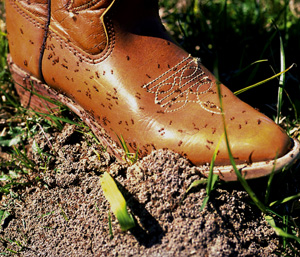 Here are few things you might not have thought of:
Here are few things you might not have thought of:- Fire ants like to eat trash and drink water from leaky pipes and puddles, just like so many other pests. Keep your outdoor trash and recycling areas tidy, clean up food scraps left after picnics and cook outs, fix leaky pipes and correct drainage issues around the house.
(Image caption: Fire ants swarming a cowboy somewhere in TX. Photo courtesy of Texas A&M University.)
- Lots of other ant species will fight and kill fire ants - they're competitors! So, when trying to get rid of fire ants, don't go crazy and kill other kinds of ants, since they may actually be helping you.
- Mark fire ant mounts with a flag or something else bright and eye-catching, and warn people to avoid them. Fire ants only bite when their nests are disturbed, i.e. by stepping on them. They won't come looking to bite you if you stay out of their way!
- The least-toxic, and most-often-cited strategy for fire ants is plain old hot water. Some sources recommend mixing in a little soap, but either way, it's 2 or 3 gallons of hot water poured slowly over the mound. This drowns many of the ants, and annoys the rest of them enough that they move their nest elsewhere. You might have to do it 2 or 3 times over the course of a week to finish them off.
- And of course, the pretty obvious thing that I forgot when I was in the garden last week: wear socks and shoes, or better, rubber boots (or cowboy boots?!) when working in areas prone to fire ants.
That's all for now! Check out this article from the Toxic Free News archives - it includes a description of the "yellow flag system" used to control fire ants at Elizabeth City public schools. And stay tuned for my article on fire ant management coming up in the next issue of Toxic Free News!
 I fell in to a burning ring of fire (ants)....I went down down down, and the flames went higher....and it burns burns burns, that ring of fire....that ring of fire! Too bad we already missed Ashburn, GA's Fire Ant Festival last March. But, it's good to know that other states with longer-standing fire ant problems are keeping a good sense of humor about them....bodes well for NC!
I fell in to a burning ring of fire (ants)....I went down down down, and the flames went higher....and it burns burns burns, that ring of fire....that ring of fire! Too bad we already missed Ashburn, GA's Fire Ant Festival last March. But, it's good to know that other states with longer-standing fire ant problems are keeping a good sense of humor about them....bodes well for NC!
